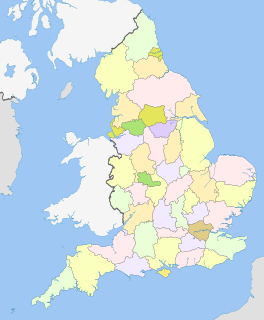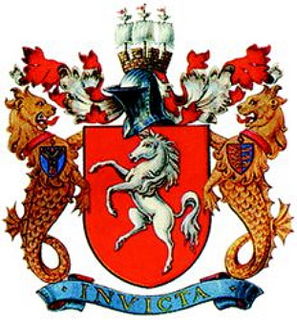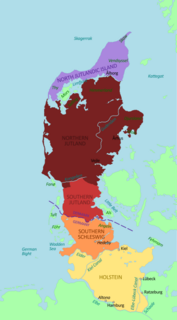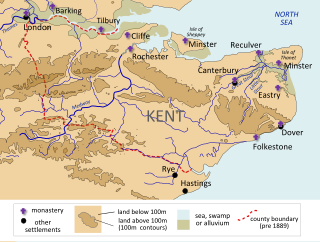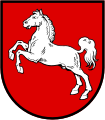
Hengist and Horsa are legendary brothers said to have led the Angles, Saxons and Jutes in their invasion of Britain in the 5th century. Tradition lists Hengist as the first of the Jutish kings of Kent.

The coat of arms of Manitoba is the heraldic symbol representing the Canadian province of Manitoba. The arms contains symbols reflecting Manitoba's British heritage along with local symbols. At the upper part of the shield is the red cross of St. George, representing England. The lower portion of the shield features a bison standing atop a rock on a green background.
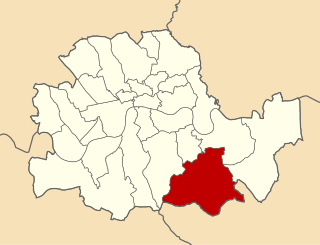
The Metropolitan Borough of Lewisham was a Metropolitan borough in the County of London between 1900 and 1965, when it became part of the London Borough of Lewisham along with the Metropolitan Borough of Deptford.

The coat of arms of Bulgaria consists of a crowned golden lion rampant over a dark red shield; above the shield is the Bulgarian historical crown. The shield is supported by two crowned golden lions rampant; below the shield there is compartment in the shape of oak twigs and white bands with the national motto "Unity makes strength" inscribed on them.
The coat of arms of the Isle of Wight was granted to the former Isle of Wight County Council in 1938. The arms were transferred to the new unitary Isle of Wight Council when the county council along with Medina and South Wight district councils were abolished in 1995.

The first coat of arms of Montreal was designed by Jacques Viger, the first mayor of Montreal, and adopted in 1833 by the city councillors. Modifications were made some one hundred five years later and adopted on 21 March 1938, and again on 13 September 2017, resulting in the version currently in use. The coat of arms was the only city emblem representing Montreal until 1981, when a stylized logo was developed for common daily use, reserving the coat of arms for ceremonial occasions.

The Corporate Logo of the City of Sydney was adopted by the City Council in 1996. It includes a graphic artist's "version" of parts of the actual arms.

The coat of arms of Kirklees Metropolitan Borough Council was granted on 24 June 1974. This was just a few months after the district of Kirklees was created as part of the new metropolitan county of West Yorkshire. It is rarely used by the Council who, until 2007, preferred to use a logo that is based upon the arms.

The Flag of Kent is the flag of the English county of Kent. It features the white horse of Kent on a red background, a theme used in several other Kent related coats of arms and logos or symbols. It is sometimes referred to as the Invicta Flag or Invicta Flag of Kent, after the motto of Kent, Invicta.
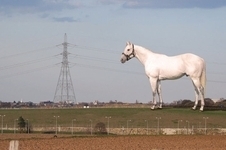
The White Horse at Ebbsfleet, formerly the Ebbsfleet Landmark, colloquially the Angel of the South, was a planned white horse statue to be built in the Ebbsfleet Valley in Kent, England. Designed by Mark Wallinger to faithfully resemble a thoroughbred horse, but at 33 times life size, the colossal sculpture was to be 50 metres (160 ft) high.
Invictaway was an express commuter coach service from Kent to London in the 1980s and 1990s, and was also a holding company for the emerging Arriva group. As a legal entity of the Maidstone & District bus company, after the cessation of the Invictaway coach services, the Invictaway company legal lettering persisted as a holding company for the Arriva subsidiaries in Kent, and some London operations. This company was based in the Armstrong Road M&D depot in Maidstone. This ceased in 1997 when the operations were reconstituted as Arriva London and Arriva Southern Counties.

The Saxon Steed is a heraldic motif associated with Lower Saxony and Westphalia.

The coat of arms of Newport is the heraldic emblem of the city of Newport, South Wales. Also known as the Civic Badge, it has been borne by the present Newport City Council since 24 July 1996 following the municipal reorganisation in April that year.
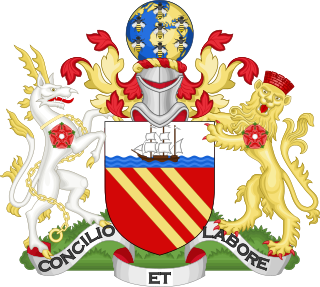
The City of Manchester in North-West England has traditionally been represented by various symbols. Most of these symbols are derived from heraldic emblems contained within the city's official heraldic achievement, which was officially adopted when the Borough of Manchester was granted city status in 1842. Notably, the motif of the worker bee has been widely used to represent the city as a symbol of industry.

The coat of arms of the London Borough of Croydon is the official heraldic arms of the London Borough of Croydon, granted on 10 December 1965.


